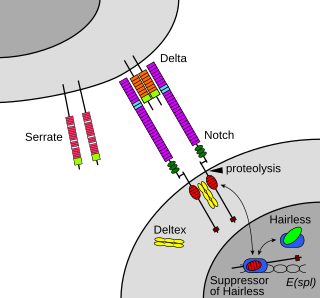
Sonic hedgehog protein(SHH) is encoded for by the SHH gene. The protein is named after the character Sonic the Hedgehog.

Drosophila embryogenesis, the process by which Drosophila embryos form, is a favorite model system for genetics and developmental biology. The study of its embryogenesis unlocked the century-long puzzle of how development was controlled, creating the field of evolutionary developmental biology. The small size, short generation time, and large brood size make it ideal for genetic studies. Transparent embryos facilitate developmental studies. Drosophila melanogaster was introduced into the field of genetic experiments by Thomas Hunt Morgan in 1909.

The Notch signaling pathway is a highly conserved cell signaling system present in most animals. Mammals possess four different notch receptors, referred to as NOTCH1, NOTCH2, NOTCH3, and NOTCH4. The notch receptor is a single-pass transmembrane receptor protein. It is a hetero-oligomer composed of a large extracellular portion, which associates in a calcium-dependent, non-covalent interaction with a smaller piece of the notch protein composed of a short extracellular region, a single transmembrane-pass, and a small intracellular region.

The primitive streak is a structure that forms in the early embryo in amniotes. In amphibians the equivalent structure is the blastopore. During early embryonic development, the embryonic disc becomes oval shaped, and then pear-shaped with the broad end towards the anterior, and the narrower region projected to the posterior. The primitive streak forms a longitudinal midline structure in the narrower posterior (caudal) region of the developing embryo on its dorsal side. At first formation the primitive streak extends for half the length of the embryo. In the human embryo this appears by stage 6, about 17 days.
The border cells are a cluster of 6-8 cells that migrate in the ovariole of the fruit-fly Drosophila melanogaster, during the process of oogenesis. A fly ovary consists of a string of ovarioles or egg chambers arranged in an increasing order of maturity. Each egg chamber contains 16 central germline, nurse cells surrounded by a monolayer epithelium of nearly 1000 follicle cells. At stage 8 of oogenesis, these cells initiate invading the neighbouring nurse cells, and reach the oocyte boundary by Stage 10.
Decapentaplegic (Dpp) is a key morphogen involved in the development of the fruit fly Drosophila melanogaster and is the first validated secreted morphogen. It is known to be necessary for the correct patterning and development of the early Drosophila embryo and the fifteen imaginal discs, which are tissues that will become limbs and other organs and structures in the adult fly. It has also been suggested that Dpp plays a role in regulating the growth and size of tissues. Flies with mutations in decapentaplegic fail to form these structures correctly, hence the name. Dpp is the Drosophila homolog of the vertebrate bone morphogenetic proteins (BMPs), which are members of the TGF-β superfamily, a class of proteins that are often associated with their own specific signaling pathway. Studies of Dpp in Drosophila have led to greater understanding of the function and importance of their homologs in vertebrates like humans.
In developmental biology, the cells that give rise to the gametes are often set aside during embryonic cleavage. During development, these cells will differentiate into primordial germ cells, migrate to the location of the gonad, and form the germline of the animal.
In the field of developmental biology, regional differentiation is the process by which different areas are identified in the development of the early embryo. The process by which the cells become specified differs between organisms.
Argos is a secreted protein that is an inhibitor of the epidermal growth factor receptor (EGFR) pathway in Drosophila melanogaster. Argos inhibits the EGFR pathway by sequestering the EGFR ligand Spitz. Argos binds the epidermal growth factor domain of Spitz, preventing interaction between Spitz and EGFR. Argos does not directly interact with EGFR. Argos represents the first example of ligand sequestration as a mechanism of inhibition in the ErbB (EGFR) family.
In early Drosophila development, the first 13 cells pass through mitosis are nuclear divisions (karyokinesis) without cytokinesis, resulting in a multinucleate cell. Pole cells are the cells that form at the polar ends of the Drosophila egg, which begin the adult germ cells. Pole plasm functions to bud the development of pole cells, as well as restore fertilization, even when the cell was previously sterile.
Orthodenticle (otd) is a homeobox gene found in Drosophila that regulates the development of anterior patterning, with particular involvement in the central nervous system function and eye development. It is located on the X chromosome. The gene is an ortholog of the human OTX1/OTX2 gene.
Slit is a family of secreted extracellular matrix proteins which play an important signalling role in the neural development of most bilaterians. While lower animal species, including insects and nematode worms, possess a single Slit gene, humans, mice and other vertebrates possess three Slit homologs: Slit1, Slit2 and Slit3. Human Slits have been shown to be involved in certain pathological conditions, such as cancer and inflammation.

Notch proteins are a family of type-1 transmembrane proteins that form a core component of the Notch signaling pathway, which is highly conserved in metazoans. The Notch extracellular domain mediates interactions with DSL family ligands, allowing it to participate in juxtacrine signaling. The Notch intracellular domain acts as a transcriptional activator when in complex with CSL family transcription factors. Members of this Type 1 transmembrane protein family share several core structures, including an extracellular domain consisting of multiple epidermal growth factor (EGF)-like repeats and an intracellular domain transcriptional activation domain (TAD). Notch family members operate in a variety of different tissues and play a role in a variety of developmental processes by controlling cell fate decisions. Much of what is known about Notch function comes from studies done in Caenorhabditis elegans (C.elegans) and Drosophila melanogaster. Human homologs have also been identified, but details of Notch function and interactions with its ligands are not well known in this context.

The halloween genes are a set of genes identified in Drosophila melanogaster that influence embryonic development. All of the genes code for cytochrome P450 enzymes in the ecdysteroidogenic pathway (biosynthesis of ecdysone from cholesterol). Ecdysteroids such as 20-hydroxyecdysone and ecdysone influence many of the morphological, physiological, biochemical changes that occur during molting in insects.
The Nodal signaling pathway is a signal transduction pathway important in regional and cellular differentiation during embryonic development.
Slit-Robo is the name of a cell signaling protein complex with many diverse functions including axon guidance and angiogenesis.
Dally is the name of a gene that encodes a HS-modified-protein found in the fruit fly. The protein has to be processed after being codified, and in its mature form it is composed by 626 amino acids, forming a proteoglycan rich in heparin sulfate which is anchored to the cell surface via covalent linkage to glycophosphatidylinositol (GPI), so we can define it as a glypican. For its normal biosynthesis it requires sugarless (sgl), a gene that encodes an enzyme which plays a critical role in the process of modification of dally.

Spitz is a protein in fruit flies which is the major activator of Epidermal Growth Factor Receptor (EGFR).

Spätzle or spaetzle is an evolutionarily-conserved arthropod protein first identified in Drosophila melanogaster. It plays a role in embryonic development and in the insect innate immune response. The name was coined by the Nobel laureate Christiane Nüsslein-Volhard after the Spätzle noodle-like form of homozygous mutant fly larvae.

Primordial germ cell (PGC) migration is the process of distribution of primordial germ cells throughout the embryo during embryogenesis.









